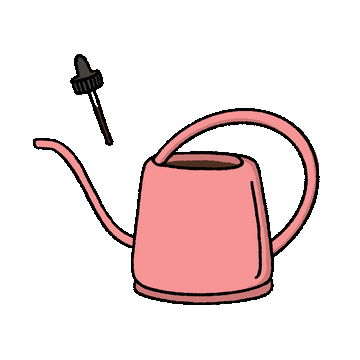What colour is your thumb, when it comes to looking after indoor plants? If you’re reading this, we’re guessing maybe it’s not massively green? Or perhaps you’re just enquiring ‘for a friend’? We know that green thumbs are those smarty pants’ who can’t seem to put a foot (or a thumb?) wrong, when it comes to caring for plants and gardens. Are they some sort of nerds, or gurus? Have they studied widely in the field (possibly literally)? Or is it something you’re either born with or you’re not? What’s the difference between a brown thumb and a black thumb? Is a brown thumb someone who consistently has bad luck with indoor plants tending to die on them; a black thumb a serious serial killer of house plants? These puzzling questions and related issues are discussed below as we catalogue the durable dozen, or 12 indoor house plants you probably won’t kill.
Regardless of thumb colour, skin colour, mother tongue or creed, all humans love indoor plants; furthermore, we need them in our lives! If you don’t like house plants, it might be that you actually have a black heart! OK, we’ve probably taken it a step too far there. But seriously folks, as voiced in a recent blog here, the science is out: plants, greenery, grass, trees – all of it – is really good for you in so many ways. Your life is a bit worse off if you don’t get a regular dose of the green stuff.
As mentioned last time on this platform, increasingly architects are specifying clever incorporation of green features into city buildings. They refer to it as ‘biophilic design’. This expression comes from the Ancient Greek meaning love of living things. No mere coincidence that we derive this term from the ancients – they knew even back then that immersion in green is a well-being wunderkind. The Japanese have a tradition called ‘shinrin-yoku’, which translates directly to forest bathing. Other cultures have various versions and customs.
Connecting with mother nature; immersing yourself in green; surrounding yourself by gorgeous indoor plants; these things enrich your life. That is proven by science, it ain’t no myth.
What we do think is a myth is that some people have a black thumb. We don’t believe in the black thumb. When you ask kindergarten kids, “What do you need to grow plants?” they all know the answer: seeds, sun, soil, water. And none of them believes themselves to be black thumbed. If you regard yourself as a plant killer, it’s because you’ve made some mistakes, maybe you need to learn a few simple principles (very simple); maybe you’ve been given the wrong advice? Maybe you just neglected house plants you had previously, hmmm?
Anyone can learn to grow house plants successfully. Although it’s not rocket science, you could always educate yourself with some literature. We do recommend a recently released book called – amazingly –‘Green Thumb', by Craig Miller-Randle. He believes like us, that no-one is born with a green thumb, but anyone can grow one!
Have you been paying attention?
Because some important words have already appeared above.
They are:
tending
you will need to tend to your indoor plants - even the hardiest - if you do not, you will indeed fulfill your self-defeating fallacy.
probably
note well, we use the qualifying adverb ‘probably’, because we cannot guarantee you will not kill your house plants. For example, if you totally fail to tend to said plants as discussed.
mother tongue
one of our favourite hard-to-kill plants also has one of our favourite names:
Mother-in-Law’s Tongue – AKA ‘Snake Plant.’
Simple tips for the Green Thumb curious:
Sunlight.
All plants need some sunlight. Some need lots, some only a little. The indoor plants we list below will get by with minimal sunlight, but not zero. Plants have to photosynthesize, turning light into chemical energy which fuels their growth. Make sure that even your most stalwart house plants get some rays; even indirect sunlight will probably be sufficient, OK?
Soil.
The soil acts as a food source and anchors the plant in its little home, as well as holding the water around the roots for it. Now, those of you who are house plant care challenged, we’re guessing you are not too excited about the idea of re-potting. We are going to suggest plants which shouldn’t need to be re-potted very often, if ever. But if for some reason your indoor plant has lost all the soil surrounding it, chances are it’s not going to make it, alright?
Water.
All plants need it. Some not so much, some heaps. With many indoor plants, you can under water them, and you can also over water them! With our tough twelve – both of these mistakes are very hard to make! But, even a cactus in the desert needs water from time to time, and so will yours. Got it?
Don’t be a Dork.
Don’t set yourself up for failure by purchasing plants which are totes inappropes! If you know that gardening isn’t your strongest suit, don’t go buying fancy fellows who need heaps of special attention. Stick with a few from our brief below. When you find you’re going just swimmingly with one/some of these, then try your hand at something more ambitious. Savvy?
What do these hardy house plants have in common?
Generally speaking, the indoor plants we itemise here share the following characteristics:
- Can survive periods of being neglected.
- Will thrive in low-light or indirect light.
- Happy in typical household conditions (humidity/temperature).
- Grow fine in standard potting mix.
Without further ado, we bring you the Plant Runner’s Die-hard Dozen; our top 12 indoor house plants that you probably won’t kill:
The Snake Plant
Variously known as Snake Plant and ‘Mother-in-Law’s Tongue’, Sansevieria trifasciata has great names and has also been compared to the fire emoji! Comes in a few attractive varieties, and when mature can produce small white flowers. It looks good anywhere in your house, fills a space nicely (particularly vertically) and is a NASA-approved air purifier! That means not only does it turn carbon dioxide into oxygen, like all other plants; it takes it to the next level by soaking up nasty toxins which may be around, such as benzene, formaldehyde and trichloroethylene. We hope you don’t have too much of these molecules floating around your place, but in case you do – another great reason why snake plant’s for you! It can be left until the soil goes completely dry (for a while); very difficult to go wrong with this champ.
Devil’s Ivy
Another one of the tenacious twelve with a great name! Also known as Pothos (not a bad moniker either!) or Epipremnum aureum. Other aliases are ‘Devil’s Vine’ and also ‘Golden Pothos’. Cool. You want one just going on the nomenclature, right? Some say the easiest indoor plant ever. Has heart-shaped, trailing leaves. Some have funky variegated green, white and yellow colourways. Loves indirect light but will go alright in very low light and even artificial light. Doesn’t care if the soil goes totally dry for a spell. The vines will just keep on growing if you let them; simply cut back when you feel the urge – you won’t hurt it!
Spider Plant
We also think this one’s got a nifty name. Don’t you think? Chlorophytum comosum are known by this arachnid reference due to the small bundles of mini-plants which tend to accrue at the ends of its runners. Spider plant has similar colours to snake plant. Also tends to go variegated. Thrives in just about any conditions and especially likes hanging out in the kitchen (generally makes a terrific hanging plant). Not known to be killed by conventional weapons or pests/diseases. You might over them if you’re giving them a drink every day. So leave ‘em alone! Once in a while is fine…
Madagascar Dragon Tree
Also sounds like the sort of indoor plant you need to own, right? Dracaena marginate can grow to be very large in their natural habitat, but if kept in a pot in your house, will just fill out to a nice size, will look rather striking and won’t ask for much attention at all. They won’t need any extra fertiliser or fuss, just a bit of H2O and some occasional cutting back. They can display some crazy vivid colours too.
Aloe Vera
Aloe barbadensis is a type of succulent, which you may have seen growing wild around the beach in Thailand or sand dunes in Australia when you’ve been on holiday, and used some of that gel inside to treat sunburn. Easy to grow at home. All succulents are. Likes to reside in a sunny window space. Is beautiful in an unassuming, simple way. Don’t give it too much water.
Chinese Evergreen
Aglaonema sp. is super sturdy, has some really fun whacky colours (pinks!) and wonderfully shaped leaves. Grows slowly but surely. You can forget about it for a while if you want, but with those pretty mottled leaves, we don’t think it’s forgettable at all.
Rubber Plant
Ficus elastica is a tough cookie! The dark leaves are most handsome; this one grows quite fast, prefers decent light and a bit of water. Put it in a large pot with well-draining mix.
Bromeliads
Bromeliaceae are a family of lush plants which bloom in all sorts of fabulous bright colours. They prefer humidity but don’t care about the temperature. They do need to live in soil or mix which drains well.
Flaming Katy
Kalanchoe blossfeldiana seriously likes to be left to its own devices, so is a perfect choice for you neglectors out there. They are ideal window-sill dwellers and sport flowers in reds, yellows, oranges, whites and pinks! A bit of water every couple of weeks will do the trick.
Jade Plant
Crassula ovata has a sense of mystery to it and has long been thought to bring good luck. They are thick and sturdy yet cute; they require little attention – just some reasonable sunlight and watering when they dry out. You’ll know when to water them as they will shrink. Rub your tattslotto tickets on their leaves.
Ponytail Palm
Beaucarnea recurvata is a hip looking player - visually quite interesting - which will grow to about a metre or so indoors, likes to live in succulent potting mix with a bit of sand ideally. Hates too much water!
ZZ Plant
Zamioculcas zamiifolia is a really popular indoor plant recently. Has groovy shaped leaves, grows into a nice form and size – perfect for the home office. You can trim a bit if it starts getting too big for its spot. TLC free.
So there you have it folks, that’s our top 12 indoor house plants you probably won’t kill. There are quite a few others which are easy to care for too. For more information, contact us anytime at the Plant Runner. Bye for now!



Leave a comment